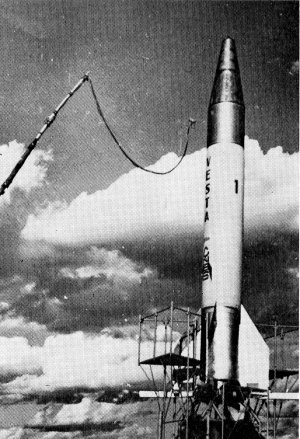Vesta (rocket)
Vesta is a rocket designed for the purpose of launching satellites into orbit. Named after Vesta, the virgin goddess of hearth, home, and family in Roman mythology, the Vesta rocket represents a significant advancement in space exploration and satellite deployment technologies. While the specifics of its design, capabilities, and operational history might be expansive, this article aims to provide a comprehensive overview of the Vesta rocket, highlighting its development, specifications, and contributions to the field of aerospace engineering.
Development[edit | edit source]
The development of the Vesta rocket was initiated by a consortium of space agencies and private aerospace companies aiming to create a reliable, cost-effective launch vehicle capable of servicing both commercial and scientific missions. The project sought to address the increasing demand for satellite launches by providing a versatile platform capable of accommodating a wide range of payloads and orbital requirements.
Design and Specifications[edit | edit source]
The Vesta rocket features a modular design, allowing for various configurations to suit specific mission profiles. This flexibility is achieved through the use of different booster stages, payload fairings, and propulsion systems, enabling the Vesta to carry payloads ranging from small CubeSats to larger communication satellites.
Stages[edit | edit source]
Typically, the Vesta rocket comprises three main stages:
- The first stage is powered by liquid fuel engines, designed for maximum thrust and efficiency during initial ascent.
- The second stage, which is smaller, focuses on precise orbital insertion and employs a combination of liquid and solid propulsion.
- The third and final stage is often customizable, depending on the payload and target orbit, and may include additional propulsion units or satellite deployment mechanisms.
Payload Capacity[edit | edit source]
The payload capacity of the Vesta rocket varies according to the mission configuration and target orbit. It is capable of delivering payloads of up to several tonnes to Low Earth Orbit (LEO) and can also reach Geostationary Transfer Orbit (GTO) with reduced payload mass.
Launch History[edit | edit source]
The Vesta rocket has a track record of successful launches, each contributing valuable data to improve future missions. Its launch history reflects a steady progression in terms of payload capacity, reliability, and efficiency. Details of specific missions, including launch dates, payloads, and outcomes, are documented in the rocket's launch log.
Impact on Space Exploration[edit | edit source]
The introduction of the Vesta rocket has had a profound impact on space exploration and satellite deployment. Its versatility and cost-effectiveness have made satellite access more feasible for a broader range of users, including smaller nations, research institutions, and private enterprises. Furthermore, the Vesta has played a crucial role in advancing our understanding of space and fostering international collaboration in space research and exploration.
Future Prospects[edit | edit source]
Looking ahead, the Vesta rocket is set to continue its role in advancing space exploration. Plans for its future use include deep space missions, interplanetary exploration, and the deployment of next-generation satellite constellations. Continuous improvements in its design and capabilities are expected to further enhance its performance and reliability.
Navigation: Wellness - Encyclopedia - Health topics - Disease Index - Drugs - World Directory - Gray's Anatomy - Keto diet - Recipes
Search WikiMD
Ad.Tired of being Overweight? Try W8MD's physician weight loss program.
Semaglutide (Ozempic / Wegovy and Tirzepatide (Mounjaro / Zepbound) available.
Advertise on WikiMD
WikiMD is not a substitute for professional medical advice. See full disclaimer.
Credits:Most images are courtesy of Wikimedia commons, and templates Wikipedia, licensed under CC BY SA or similar.Contributors: Prab R. Tumpati, MD

